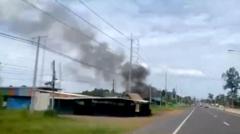Fighting erupted along the Thailand-Cambodia border on Thursday, with at least 12 Thai nationals, primarily civilians, reported dead, according to Thai authorities. The humanitarian impact on the Cambodian side remains unclear, as both nations trade accusations for the skirmish that follows a long history of conflict.
The roots of the dispute trace back to the drawing of borders during the French colonial era, intensifying significantly in 2008 when Cambodia aimed to register a historic temple site as a UNESCO World Heritage Site, prompting protests from Thailand. Following the killing of a Cambodian soldier in a May clash, relations hit a new low, leading both countries to impose border restrictions on each other, including Cambodia halting Thai imports such as fruits and power services.
On Thursday, differing accounts emerged over the events that unfolded. Thailand’s National Security Council claimed Cambodian forces initiated the conflict after deploying drones and heavy weaponry. Conversely, Cambodia accused Thai troops of violating ceasefire agreements and provoking the confrontation. Tensions continue to mount as both nations bolster military presence along an increasingly volatile border.
Thailand's acting Prime Minister Phumtham Wechayachai emphasized the need for a careful approach in resolving the delicate situation, while Cambodian Prime Minister Hun Manet called for a peaceful resolution but stated his country would respond to aggression. Despite sporadic violent exchanges in the past, experts suggest both sides may seek to de-escalate the situation relatively quickly.
Tourism remains largely unaffected for now, although travelers are advised to exercise caution, particularly in areas closing to border crossings. The international community watches closely as the potential for further military action looms.


















